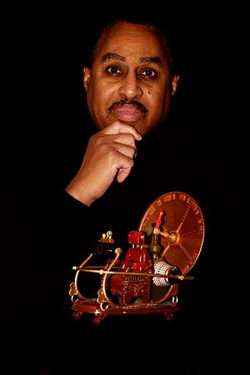April 4, 2006 feature
Professor predicts human time travel this century

With a brilliant idea and equations based on Einstein’s relativity theories, Ronald Mallett from the University of Connecticut has devised an experiment to observe a time traveling neutron in a circulating light beam. While his team still needs funding for the project, Mallett calculates that the possibility of time travel using this method could be verified within a decade.
Black holes, wormholes, and cosmic strings - each of these phenomena has been proposed as a method for time travel, but none seem feasible, for (at least) one major reason. Although theoretically they could distort space-time, they all require an unthinkably gigantic amount of mass.
Mallett, a U Conn Physics Professor for 30 years, considered an alternative to these time travel methods based on Einstein’s famous relativity equation: E=mc2.
“Einstein showed that mass and energy are the same thing,” said Mallett, who published his first research on time travel in 2000 in Physics Letters. “The time machine we’ve designed uses light in the form of circulating lasers to warp or loop time instead of using massive objects.”
• PhysOrg.com iPhone / iPad Apps
• PhysOrg.com Audio Podcasts / iTunes
• PhysOrg.com Android apps
• PhysOrg.com Blackberry app
• Join PhysOrg.com on Facebook
• Follow PhysOrg.com on Twitter
To determine if time loops exist, Mallett is designing a desktop-sized device that will test his time-warping theory. By arranging mirrors, Mallett can make a circulating light beam which should warp surrounding space. Because some subatomic particles have extremely short lifetimes, Mallett hopes that he will observe these particles to exist for a longer time than expected when placed in the vicinity of the circulating light beam. A longer lifetime means that the particles must have flowed through a time loop into the future.
“Say you have a cup of coffee and a spoon,” Mallett explained to PhysOrg.com. “The coffee is empty space, and the spoon is the circulating light beam. When you stir the coffee with the spoon, the coffee - or the empty space - gets twisted. Suppose you drop a sugar cube in the coffee. If empty space were twisting, you’d be able to detect it by observing a subatomic particle moving around in the space.”
And according to Einstein, whenever you do something to space, you also affect time. Twisting space causes time to be twisted, meaning you could theoretically walk through time as you walk through space.
“As physicists, our experiments deal with subatomic particles,” said Mallett. “How soon humans will be able to time travel depends largely on the success of these experiments, which will take the better part of a decade. And depending on breakthroughs, technology, and funding, I believe that human time travel could happen this century.”
Step back a minute (sorry, only figuratively). How do we know that time is not merely a human invention, and that manipulating it just doesn’t make sense?
“What is time? That is a very, very difficult question,” said Mallett. “Time is a way of separating events from each other. Even without thinking about time, we can see that things change, seasons change, people change. The fact that the world changes is an intrinsic feature of the physical world, and time is independent of whether or not we have a name for it.
“To physicists, time is what’s measured by clocks. Using this definition, we can manipulate time by changing the rate of clocks, which changes the rate at which events occur. Einstein showed that time is affected by motion, and his theories have been demonstrated experimentally by comparing time on an atomic clock that has traveled around the earth on a jet. It’s slower than a clock on earth.”
Although the jet-flying clock regained its normal pace when it landed, it never caught up with earth clocks - which means that we have a time traveler from the past among us already, even though it thinks it’s in the future.
Some people show concern over time traveling, although Mallett - an advocate of the Parallel Universes theory - assures us that time machines will not present any danger.
“The Grandfather Paradox [where you go back in time and kill your grandfather] is not an issue,” said Mallett. “In a sense, time travel means that you’re traveling both in time and into other universes. If you go back into the past, you’ll go into another universe. As soon as you arrive at the past, you’re making a choice and there’ll be a split. Our universe will not be affected by what you do in your visit to the past.”
In light of this causal “safety,” it’s kind of ironic that what prompted Mallett as a child to investigate time travel was a desire to change the past in hopes of a different future. When he was 10 years old, his father died of a heart attack at age 33. After reading The Time Machine by H.G. Wells, Mallett was determined to find a way to go back and warn his father about the dangers of smoking.
This personal element fueled Mallett’s perseverance to study science, master Einstein’s equations, and build a professional career with many high notes. Since the ‘70s, his research has included quantum gravity, relativistic cosmology and gauge theories, and he plans to publish a popular science/memoir book this November 2006. With help from Bruce Henderson, the New York Times best-selling author, the book will be called Time Traveler: A Physicist’s Quest For The Ultimate Breakthrough.
Copyright 2010 PhysOrg.com.
All rights reserved. This material may not be published, broadcast, rewritten or redistributed in whole or part without the express written permission of PhysOrg.com.


















